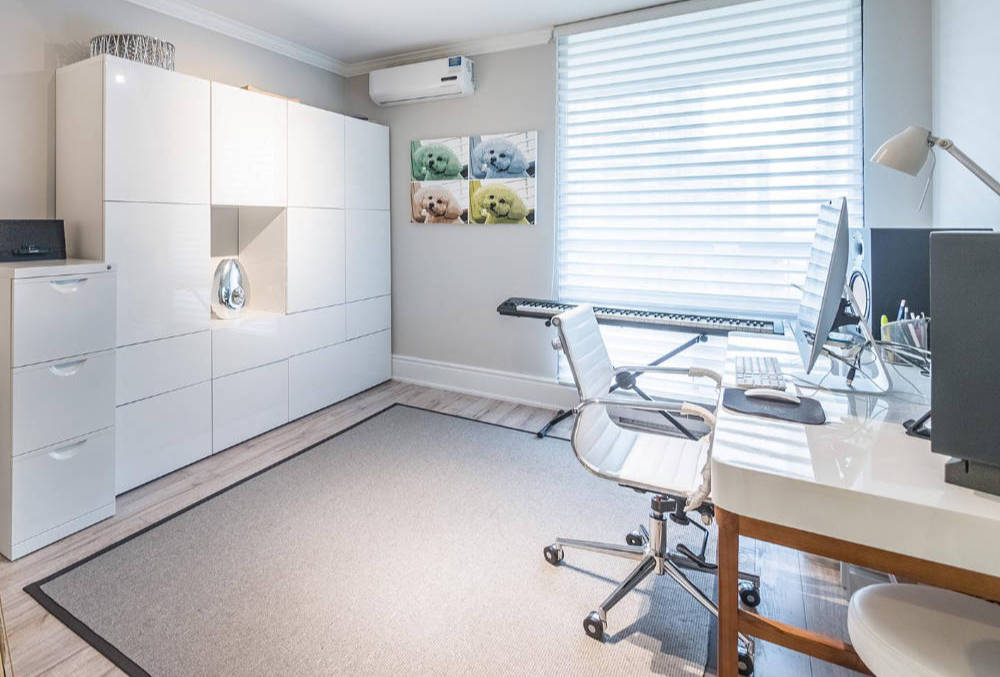The idea of working from home might make you imagine lying on your couch in sweats and typing on your laptop. This may not be the best scenario, even though it sounds like an awesome idea. Setting up an office at home that meets your needs will help you to be more productive during those long work hours.
While making a room look great is a primary focus for us as Interior Decorators, designing a home office has a different set of challenges that need to be addressed first.
Tips for Setting up an Office at Home
Choosing the right area in your home to set up your home office and to get the proper supplies and equipment to make it work is priority number one. For the sake of your health and productivity, it is important that you can be comfortable for long hours.
The following tips will help you set up a home office for remote work with helpful equipment to improve productivity.
1. Establishing a Remote Work Office at Home
How do you begin? Start by establishing a home office space in your house. Separate rooms are great if you have them. It is possible to split the use of the extra room between a guest room and an office if you have some flexibility to make that work.
Here, you’ll find tips and strategies on how to set up a successful and productive home office.
If your available space is limited, a Murphy bed may be an option for you. If an alcove in your home is the only space available, make sure it is out of the path of the family’s traffic and that it is private enough to get your work done. Adding built-ins to your home office can also help you make the most of your space.
Sunrooms, screened-in patios and the kitchen breakfast nook can all be used as office areas in temperate climates. Here are some tips for setting up and starting to work remotely once you’ve selected a workspace.
2. Internet, electrical outlets, and backup power sources
Think about how many plugs you’ll need and how many outlets there are. In order to be safe, opt for a power strip with multiple ports, USB connections, and surge protection. You should be able to use your home wireless router if you need to access the internet only for tasks that do not consume large amounts of data, such as research or file sharing.
Having solid hi-speed internet access is the best option for those who have to make multiple teleconference calls or use company VPNs throughout their day. Streaming with a large amount of data is possible when you use a business connection with your internet provider. It is also possible to use an upgraded wireless router.
Taking steps for a power outage is something many people overlook when setting up their home office. Normally, a single laptop can be powered during a power outage, however, a desktop will not. When a power outage lasts for a prolonged period of time, an emergency backup system can provide you with power.
It is also important to consider that a desktop computer with peripherals and a printer will put a lot of strain on your home’s electricity. Turn on your computer and electric appliances before you start working in your office to check the power drain.
3. Evening and daytime lighting for your home office setup
You may not need a desk lamp during the day, but you’ll have to use an overhead light in the evening. Instead of hard lighting in the home office that can cause eye strain and tension, consider soft-light desk lamps that create a mellow glow. You want to make sure that you are comfortable so that you can concentrate on your work.
A window facing your monitor could make it hard to see the screen as it will create excessive glare. Take note of any direct light when deciding where to set up your workstation. If you face the window, you will also find it difficult to look at your screen when there is direct sunlight coming in.
4. Consider a Built-in Desk

The photo above is from a project where we installed built-in cabinets with a desk. To keep the budget small we Ikea Billy bookcase cabinets and bridged the 2 tall cabinets together with a desktop. We added a second shelf under the desktop to store hard drives and power bars. It has an impressive minimalist look and provides plenty of storage space.
5. Distractions and interruptions in your home office
Nothing can be as frustrating as being on the phone with lots of people around you. Setting up an office at home should follow the same guidelines as a commercial office space. When you are on the phone or participating in a conference call, you need to be quiet and concentrated. As you’ll be sharing your screen for video calls using apps like Zoom or Skype, meeting online requires privacy. Distractions are easily avoided if your office has a door.
If you do not have a closed-in work area, minimize distractions by adding cubicle walls or hanging a sheet from a curtain rod with hooks. The reason for this is so you can clearly signal that you need uninterrupted work-time and indicate that your office is in work mode. Check out this article for more information on soundproofing a home office.
Office workers who suffered from strained backs and carpal tunnel syndrome, which can lead to surgical intervention, became familiar with ergonomics years ago. Setting up an office at home that is both comfortable and healthy for you is not to be taken lightly.
- If possible, choose a chair that protects your spine and gives you a flat surface on which to put your feet. To compensate for short legs, use a footstool. Here are some excellent Ergonomic Office Chairs that you can get from Amazon.
- Monitors and laptops should be at arms’ length, with the top of the screens close to your eyes. If you want to ensure that you have the freedom to move around your home office, it is crucial to have the right flooring.
- Keeping staplers, notepads, and pens close by will keep you from aching, stretching, and damaging your muscles and ligaments. It will save you time as well. When you use an ergonomic keyboard, you minimize arm movement by keeping your mouse at the same height. Avoid putting pressure on the nerves or veins by keeping your wrists straight as you type or use the mouse.
- Purchase a high-quality microphone headset so you can use your hands freely and never cradle your phone between your neck and chin. Home offices designed so that you can work remotely need to be ergonomically designed.
6. Consider a Virtual Assistant?
You may be losing the convenience of an office manager or secretary if you work remotely. Amazon’s Alexa, Google Assistant or Siri can provide you with audio reminders if you set them up. Working from home can mean staying on track with a computer calendar or the sound of a voice reminding you of what’s coming up.
As you think about an idea, these handy devices can be used to take notes for you, allowing you to use your keyboard instead. They can also research facts quickly and look up facts quickly. Dictation and transcription are also possible with speech recognition software that is built-in to many modern computers today.
7. How About a Virtual Room Design?
If you don’t have a budget for our full decorating services, consider our virtual room design service. Just send us a picture of your room and provide details about your needs. We’ll send back a rendering of our suggested room design within 48 hours.
Make it a goal to set up a home office for remote work that will help you to be as productive as possible, with minimal distraction and maximum comfort. Make it ergonomic and you will be able to do your best work without being distracted by discomfort.
We hope this guide has provided you with some good home office setups ideas so you can get started with your home office setup.
We specialize in designing a home office setup so don’t hesitate to get in touch if you need some help.

